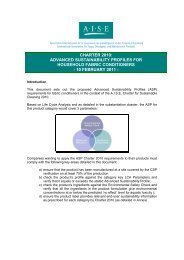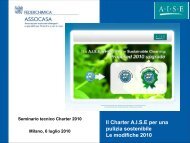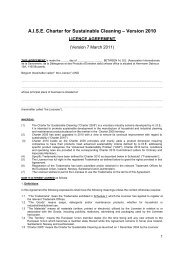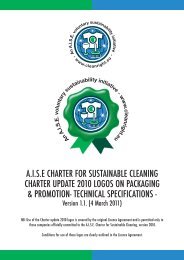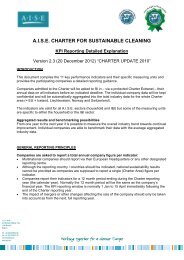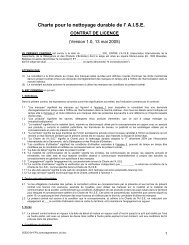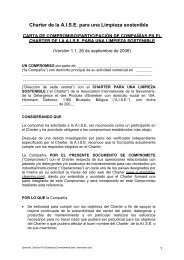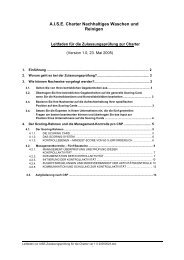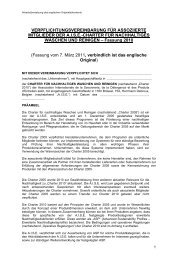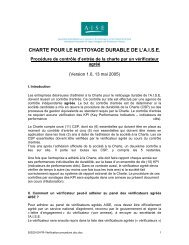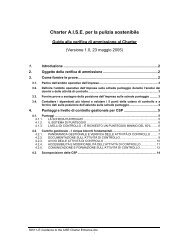ASP Substantiation Dossier - Sustainable Cleaning
ASP Substantiation Dossier - Sustainable Cleaning
ASP Substantiation Dossier - Sustainable Cleaning
Create successful ePaper yourself
Turn your PDF publications into a flip-book with our unique Google optimized e-Paper software.
Charter 2010 – <strong>ASP</strong> <strong>Substantiation</strong> <strong>Dossier</strong>:<br />
“Liquid Laundry Detergents (household)”<br />
Ver 1 October 2010<br />
A.I.S.E. is the voice of the Soaps, Detergents and Maintenance Products Industry in Europe. Its<br />
membership comprises of 37 National Association in 42 countries and 10 companies that are direct<br />
members. In total, A.I.S.E. represents more than 900 companies that are involved in the household<br />
market and/or in the Industrial & Institutional cleaning domain, thus representing the vast majority of<br />
the companies in this domain.<br />
1) Introduction<br />
A.I.S.E. strongly believes that it has a key role to play in driving mainstream changes for more<br />
sustainable consumption and production patterns. In this spirit, it has developed and implemented<br />
over the last 12 years a number of voluntary initiatives aimed at the whole sector. The objective of<br />
these various initiatives is to help drive sustainability/environmental improvements for the majority of<br />
products in our sector, by steering all players towards more sustainable practices in the industry and<br />
helping to deliver substantial savings of resources to society.<br />
Its main horizontal project is the A.I.S.E. Charter for <strong>Sustainable</strong> <strong>Cleaning</strong>. Launched in 2005, this<br />
voluntary initiative is a comprehensive life-cycle-based framework for promoting a common industry<br />
approach to sustainability improvement and reporting.<br />
From the outset, the Charter has been seen as a living scheme, with a broad commitment to update it<br />
regularly. On 2 December 2009, A.I.S.E. announced the upcoming launch of “Charter 2010”. A key<br />
component of Charter 2010 is the addition of a ‘Product Dimension’. The inclusion of a Product<br />
Dimension further strengthens the scheme by enabling it to more completely cover the whole life of a<br />
product in terms of sustainability, from manufacturing to end-use. This will also signal to consumers<br />
that a product is environmentally friendly, allowing them to make a more informed choice of products.<br />
This is achieved by creating “Advanced Sustainability Profiles” (<strong>ASP</strong>s) for each major product<br />
group. The <strong>ASP</strong>s are designed to determine a set of minimum criteria that a product must meet, in<br />
order to be considered as an example of a product with a good sustainability profile.<br />
Bearing in mind the success of several voluntary initiatives initiated by the whole industry (e.g. of<br />
A.I.S.E. Code of Good Environmental Practice 1 , A.I.S.E. Charter for <strong>Sustainable</strong> <strong>Cleaning</strong> 2005 2 ), it is<br />
A.I.S.E.’s view and experience that only Industry Association-led initiatives could make consumers’<br />
habits switch to more sustainable patterns. This is because such an approach can build on and<br />
benefit from a coordinated communication campaign that can only be possible in such a context.<br />
Moreover the potential of such initiatives has been increasingly recognized by the European<br />
1<br />
After the 5 years of the code operation (ending 2001), the industry achieved: energy consumption – 6.4% reduction per<br />
wash; laundry detergent use – 7.9% reduction per capita, 16.0% reduction per wash; packaging use – 6.7% reduction per<br />
capita, 14.9% reduction per wash; poorly biodegradable ingredients – 23.7% reduction per capita, 30.4% reduction per wash.<br />
2<br />
From 2006 to 2008, Charter member companies achieved: Chemicals covered by HERA: +10%; Use of poorly biodegradable<br />
organics: -13%; Energy consumed per tonne of production: -4%; CO 2 emitted per tonne of production: -4%; Packaging per<br />
tonne of production: -9%; Products with at least two safe use icons: +22%.<br />
1
Commission to the point that it has been explicitly addressed in the SCP/SIP Action Plan/Review of<br />
Ecodesign Directive 3 .<br />
This document provides details on the processes used to develop the Advanced Sustainability<br />
Profile for the product group “Liquid Laundry Detergents for Household Use”.<br />
2) The market (EU, plus Norway and Switzerland)<br />
Fabric washing:<br />
=> 49% of A.I.S.E. total household market value<br />
=> Market Value: 14.24 billion Euros in 2008<br />
Estimated proportion for the value of Liquid<br />
Detergents: about 28% i.e. about 4 billion Euros<br />
Source: A.I.S.E. 2008 Annual review<br />
3) <strong>ASP</strong> principles<br />
The principles applied to the setting of the <strong>ASP</strong> criteria are as follows:<br />
1. The <strong>ASP</strong> criteria should represent a target that is aspirational, but reasonably achievable<br />
by all. Our vision is that the product within the category should be able to achieve the <strong>ASP</strong><br />
targets within a reasonable timeframe without the need for significant new product innovation<br />
or process intervention.<br />
2. The <strong>ASP</strong> criteria will reflect as completely as possible the key drivers of reduced<br />
environmental impact, as determined by Life Cycle Analysis.<br />
3. The Advanced Sustainability Profile, like the Charter, is a living system, with the implicit<br />
intention to periodically increase the targets in order to move the category in the direction of<br />
continuous sustainable improvement.<br />
4. The setting of <strong>ASP</strong> criteria must always follow the established evaluation and consultation<br />
process detailed in the next section.<br />
3 - “Policy makers have shown an increasing interest in environmental agreements in recent years. The potential of such<br />
agreements between stakeholders – often representative associations of business – to contribute to environmental policy<br />
objectives is widely recognised.”, COM(2002) 412 final: COMMUNICATION FROM THE COMMISSION TO THE EUROPEAN<br />
PARLIAMENT, THE COUNCIL, THE ECONOMIC AND SOCIAL COMMITTEE AND THE COMMITTEE OF THE REGIONS,<br />
Environmental Agreements at Community Level. Within the Framework of the Action Plan on the Simplification and<br />
Improvement of the Regulatory Environment, Brussels, 17.July 2002.<br />
- “Self-regulation, including voluntary agreements offered as unilateral commitments by industry, can provide for quick<br />
progress due to rapid and cost-effective implementation, and allows for flexible and appropriate adaptation to technological<br />
options and market sensitivities”, Proposal for a DIRECTIVE OF THE EUROPEAN PARLIAMENT AND OF THE COUNCIL<br />
establishing a framework for the setting of ecodesign requirements for energy related products COM (2008) 399<br />
2
4) Process for the development of <strong>ASP</strong>s for liquid laundry detergents<br />
1. Identification of product category and installation of A.I.S.E. Task Force<br />
The A.I.S.E. Charter Steering Group (now A.I.S.E. Sustainability Steering Group (SSG))<br />
proposed on 22 February 2008 to develop <strong>ASP</strong>s for liquid laundry detergents (together with<br />
solid laundry detergents and fabric conditioners). An LCA Task Force was set up to develop<br />
such <strong>ASP</strong>s; this TF met for the first time on 26 February 2008. It was composed of experts<br />
from 6 companies, namely Henkel, Colgate Palmolive, Unilever, SC Johnson,<br />
ReckittBenckiser and P&G. Work was coordinated by the A.I.S.E. Secretariat.<br />
2. Development by the Task Force of <strong>ASP</strong> criteria and thresholds<br />
Based on an existing Life cycle analysis (see chapter 5) the TF identified relevant LCA<br />
parameters. In 2008 and 2009 a data collection on those parameters was organised by the<br />
A.I.S.E. secretariat. Four companies provided data on a representative sample of the EU<br />
market 3 . The data was collected and aggregated under strict confidentiality by the A.I.S.E.<br />
secretariat. This exercise eventually led to the decision to design a system based on<br />
thresholds.<br />
3. Internal A.I.S.E. consultation and endorsement<br />
This recommendation on a threshold system was presented for approval to the SSG on 7<br />
September 2009 and the A.I.S.E. Board on 6 October 2009. In addition this dossier was<br />
developed in order to substantiate in a transparent way the processes and the proposed<br />
thresholds.<br />
4. Internal (industry) and External consultation and activation<br />
The <strong>ASP</strong>s and the substantiation dossier were subject to consultation with Charter member<br />
companies and other interested parties (industry/external stakeholders) from 18 December<br />
2009 till 27 January 2010. Companies were asked to comment/input on:<br />
<br />
<br />
the relevance and technical feasibility of the proposed thresholds<br />
the appropriate timing for preparation of <strong>ASP</strong>s for product categories. 38% of those<br />
companies that provided feedback voted for an activation period of 6 months, 38% for<br />
1 year and 25% for more than one year. On this basis, the A.I.S.E. Board agreed on 4<br />
February 2010 on a preparation period of one year from 1 July 2010 until 30 June<br />
2011.<br />
Based on the received input, these <strong>ASP</strong>s were finalised as part of Charter 2010 and are<br />
made available to industry from 1 July 2010.<br />
3<br />
Data available at A.I.S.E. secretariat.<br />
3
5) <strong>ASP</strong> criteria and rationale<br />
A generic Life Cycle Analysis (LCA) on liquid laundry detergents was carried out before the Charter<br />
<strong>ASP</strong> targets were set, to get an understanding of the environmental impacts of the various stages of a<br />
liquid detergent’s life cycle.<br />
100%<br />
80%<br />
60%<br />
40%<br />
20%<br />
0%<br />
-20%<br />
Formulation<br />
Manufacturing<br />
Packaging<br />
Distribution<br />
Use<br />
Water Treatment<br />
Packaging Disposal<br />
Primary Energy Water Consumption Total Solid Waste<br />
The stages of the process considered were:<br />
- Formulation<br />
- Manufacturing<br />
- Packaging<br />
- Distribution<br />
- Use<br />
- Water Treatment<br />
- Packaging Disposal<br />
and the parameters evaluated were:<br />
- Primary Energy<br />
- Water Consumption<br />
- Total Solid Waste.<br />
The analysis confirms that the three most important factors in Life Cycle Analysis for Laundry<br />
Detergent Liquids are as follows:<br />
1. The most significant impact on the environment is in the use and disposal phases of the<br />
product’s life, due to the significant amounts of energy and water consumed by the washing<br />
machine. Therefore any LCA based criteria must take usage into account.<br />
2. The second most important factor to reduce environmental impact is through the reduction in<br />
resources used to manufacture the product. By concentrating Laundry Detergent Liquids,<br />
product dosage and packaging is reduced and this delivers savings in energy consumption<br />
(hence C0 2 emissions) and potential waste production, as well as delivering substantial<br />
savings in transportation as more product (doses) can be carried on one truck.<br />
4
3. Given that Laundry Detergents end up as water-borne waste, it is essential that a sustainable<br />
product poses no risk for the environment. Therefore, all “down-the-drain” product categories<br />
must pass the Environmental Safety Check (ESC).<br />
Using the above life-cycle analysis as a starting point, the A.I.S.E. Task Force in charge of setting the<br />
<strong>ASP</strong> criteria for Liquid Laundry Detergents worked on the following main components:<br />
- activities at product level, under the direct control of manufacturers:<br />
- by determining a maximum dosage of ingredients per standard wash<br />
- by determining a maximum dosage of packaging materials per standard wash<br />
- by setting a minimum level of recycled content in secondary packaging.<br />
- activities at consumer level given that this represents the highest environmental impact:<br />
- providing on-pack guidance for the most sustainable product use (e.g. low temperature<br />
washing)<br />
Implicit in the <strong>ASP</strong> criteria is that a product must deliver an acceptable level of performance at low<br />
washing temperatures (≤ 30°C).<br />
In order for a product to meet the Advanced Sustainability Criteria, it must meet the conditions in each<br />
and every domain as detailed below:<br />
<strong>ASP</strong> Criteria for Laundry Detergent Liquids and Liquidtabs<br />
Product formulation<br />
Packaging weight per job<br />
Packaging re-cycled content<br />
End User Information<br />
Performance<br />
Pass successfully Environmental Safety Check (ESC) on<br />
all ingredients<br />
AND<br />
Dosage ml/job:<br />
≤ 75ml<br />
Total (primary + secondary but excluding tertiary)<br />
packaging g/job; only non-recycled content in bottles to<br />
be taken into account:<br />
≤ 7.0g<br />
Secondary packaging:<br />
Board: ≥ 60%<br />
End-user info on-pack:<br />
Washright panel or alternative (see Annex of Advanced<br />
sustainability profiles)<br />
AND<br />
Ability to wash at ≤ 30° C indicated on pack<br />
Evidence has to be provided (in case of external<br />
verification organised by A.I.S.E.) that the product has<br />
been performance tested and reached a level<br />
acceptable to consumers consistent with claims made.<br />
5
Clarifications/Definitions:<br />
Job: following the Detergent Regulation EC 648/2004 the “standard washing machine loads are 4,5<br />
kg dry fabric for heavy-duty detergents and 2,5 kg dry fabric for low-duty detergents”.<br />
Ingredients per job/ heavy-duty detergents: based on medium water hardness and normally soiled<br />
fabric<br />
Ingredients per job/ low-duty detergents: based on medium water hardness and lightly soiled fabric<br />
Packaging weight per job: Total (primary + secondary) packaging (g/job) - based on the volume<br />
weighted average for all SKUs of one brand variant with the same formulation per country. Variants of<br />
the brand which do not pass all other <strong>ASP</strong> category tests and/or are not intended to carry the <strong>ASP</strong><br />
logo must be excluded from the calculation. Dosage devices – apart from closures – are not to be<br />
considered as packaging.<br />
Primary/secondary/tertiary packaging: following definitions from the European Parliament and Council<br />
Directive 94/62/EC of 20 December 1994 on packaging and packaging waste:<br />
- primary packaging, i. e. packaging conceived so as to constitute a sales unit to the final<br />
user or consumer at the point of purchase;<br />
- secondary packaging, i. e. packaging conceived so as to constitute at the point of<br />
purchase a grouping of a certain number of sales units whether the latter is sold as such<br />
to the final user or consumer or whether it serves only as a means to replenish the<br />
shelves at the point of sale; it can be removed from the product without affecting its<br />
characteristics; SRB (shelf ready box) and AB (American box) are to be considered as<br />
secondary packaging;<br />
- tertiary packaging, i. e. packaging conceived so as to facilitate handling and transport of a<br />
number of sales units or grouped packagings in order to prevent physical handling and<br />
transport damage.<br />
Note: Packaging which functions both as secondary (case) and tertiary (transportation unit)<br />
packaging, intended to function as an in-store free-standing floor display unit, is regarded as tertiary<br />
packaging for the purpose of this definition.<br />
Packaging re-cycled content: in countries where re-cycled board is not available and a use of it would<br />
be a disadvantage for sustainable reasons, the use of re-cycled board is not required.<br />
6
Product formulation<br />
Based on the outcome of the life-cycle analysis, the LCA experts identified the concentration of a<br />
product as one of the key factors, in order to reduce the environmental impact. Within the<br />
geographical scope of the Charter, it can be observed from products on shelves that the standard<br />
dose of liquid laundry detergents varies from 35 ml to over 120 ml (as at end 2009).<br />
In the framework of A.I.S.E.’s sustainability initiatives 4 , an LCA Expert Working Group has developed<br />
a preliminary evaluation based on the hypothesis of concentrating the current “dilute” liquid detergents<br />
to a level that would allow obtaining a performance equivalent to today’s products with a maximum<br />
dosage of 75 ml. These calculations show that this threshold has the potential to lead to an<br />
ingredients savings of around 400,000 tons in the EU 27. An industry consultation took place in 2008<br />
through the A.I.S.E. National Associations network which confirms that 75 ml is achievable by SMEs<br />
through conventional technology. Therefore it appears as setting a right balance between the aim to<br />
reach environmental savings and the possibility to achieve it through conventional technology<br />
available to all companies, including SMEs. “Conventional technology” should be understood as<br />
technology that is already widely used or readily accessible to all companies.<br />
Based on the market situation in Europe 2009 (source Nielsen), 42,9% of laundry detergent liquids<br />
fulfil the 75 ml per wash threshold. The proposed threshold therefore appears as an ambitious<br />
proposal for substantial environmental savings. This threshold was confirmed as one outcome of the<br />
consultation.<br />
Packaging<br />
Based on the outcome of the life-cycle analysis, the LCA experts identified the reduction of packaging<br />
as a further key factor, in order to reduce environmental impact. The criteria of 7g per job has been<br />
proposed on the basis that it is achievable using readily available technology but currently only met by<br />
around half the market, on the basis of data provided to A.I.S.E. The consultation sought to gain<br />
further insight into this aspect to assess the feasibility of this threshold or a lower threshold. A<br />
threshold of 7g per job was confirmed as one outcome of the consultation. In addition the consultation<br />
sought views on whether only non-recycled content in bottles should be taken into account when<br />
weighing packaging against the proposed threshold. This provision aims to encourage the use of recycled<br />
packaging.<br />
e.g. : for a given total packaging (primary + secondary) of 9g per job and containing 2.2 g per job<br />
of recycled material, only 6.8 g per job will need to be taken into account.<br />
This was confirmed in the consultation. In order to meet the target, the liquid laundry detergent will<br />
need to be packed/bottled in a way that is not wasteful, i.e. without excessive empty space in the<br />
pack/bottle, and with efficient usage of secondary packaging.<br />
4 Reference can be requested from the A.I.S.E. Secretariat.<br />
7
Secondary packaging (e.g. cartons/cases) re-cycled content<br />
The data provided to A.I.S.E. of current re-cycled secondary packaging content used by several major<br />
manufacturers, representing the majority of the laundry detergents market, indicates that the<br />
percentage of re-cycled secondary packaging material varies from 50% to 90%. The consultation<br />
sought to establish a reasonable threshold for liquid laundry detergents meeting the re-cycled content<br />
criteria. This threshold should be both achievable by manufacturing companies, using conventional<br />
technologies yet leading to environmental benefit. A threshold of 60% was confirmed. As one result of<br />
the consultation outcome, following exception will be made: In countries where re-cycled board is not<br />
available and a use of it would be a disadvantage for sustainable reasons, the use of re-cycled board<br />
is not required.<br />
End-User Information<br />
As figured out in the life-cycle analysis, the most significant impact on the environment is in the use<br />
phase of the product’s life, due to the significant amounts of energy and water consumed by the<br />
washing machine.<br />
At the end of 2008, A.I.S.E. ran a consumer survey across more than 500 consumers in 23 different<br />
countries about their current washing habits. This survey showed that there is still significant<br />
progress to be achieved in the way consumers wash. For instance:<br />
- Only 49% of washing machine loads are full<br />
- The average wash temperature is 42.6°C<br />
- Only 76% of consumers indicate that they are aware of the dosing instructions.<br />
Considerable savings, both environmentally (water, energy, CO2, chemicals), and economic (financial<br />
savings for consumers due to correct dosing and efficient use of the appliance), could be reached<br />
through better sustainable consumer behaviour. In addition to formulating products that are<br />
concentrated, it is also key to continue providing the consumers advice about wash parameters and<br />
correct dosage. Companies will be requested to use the Washright Panel, which had been introduced<br />
by A.I.S.E. in 1998 and revised in 2008, or an alternative (see Annex 2 of advanced sustainability<br />
profiles), and to indicate the ability to wash at ≤ 30° C on pack. Evidence has to be provided that the<br />
product has been performance tested and reached a level acceptable to consumers consistent with<br />
claims made. This was confirmed as one outcome of the consultation.<br />
8
6) Expected benefits<br />
With the implementation of the Advanced Sustainability Profiles for laundry liquid detergents,<br />
following benefits are expected:<br />
<br />
<br />
<br />
<br />
<br />
<br />
<br />
<br />
Reassurance that ingredients in the product formulation give environmental concentration at<br />
or below the predicted no-effect level for aquatic toxicity<br />
Optimal use of ingredients due to product compaction/concentration<br />
Optimal use of packaging due to product compaction/concentration<br />
Optimisation on transport due to reduction of product volume, thus savings on energy<br />
Savings on energy due to reduction of washing temperature<br />
Savings on water due to optimisation of fill level of washing machines<br />
Reassurance of companies’ responsibility on sustainability<br />
Promotion of sustainable behavior of end users<br />
7) Timing<br />
<br />
<br />
<br />
<br />
<br />
From 18 Dec. 2009 till 27 Jan 2010: Internal and external consultations on <strong>ASP</strong>s for laundry<br />
detergent powders and liquids and fabric conditioners<br />
By 1 July 2010: Finalisation of <strong>ASP</strong> packages<br />
By 1 July 2010: Availability of <strong>ASP</strong>s to the industry<br />
1 July 2010 till 30 June 2011: Preparation period for implementation of <strong>ASP</strong>s<br />
As from 1 July 2011: Activation – products complying with Charter 2010/<strong>ASP</strong> requirements for<br />
liquid laundry detergents can start to appear on shelves with <strong>ASP</strong> logo<br />
9




